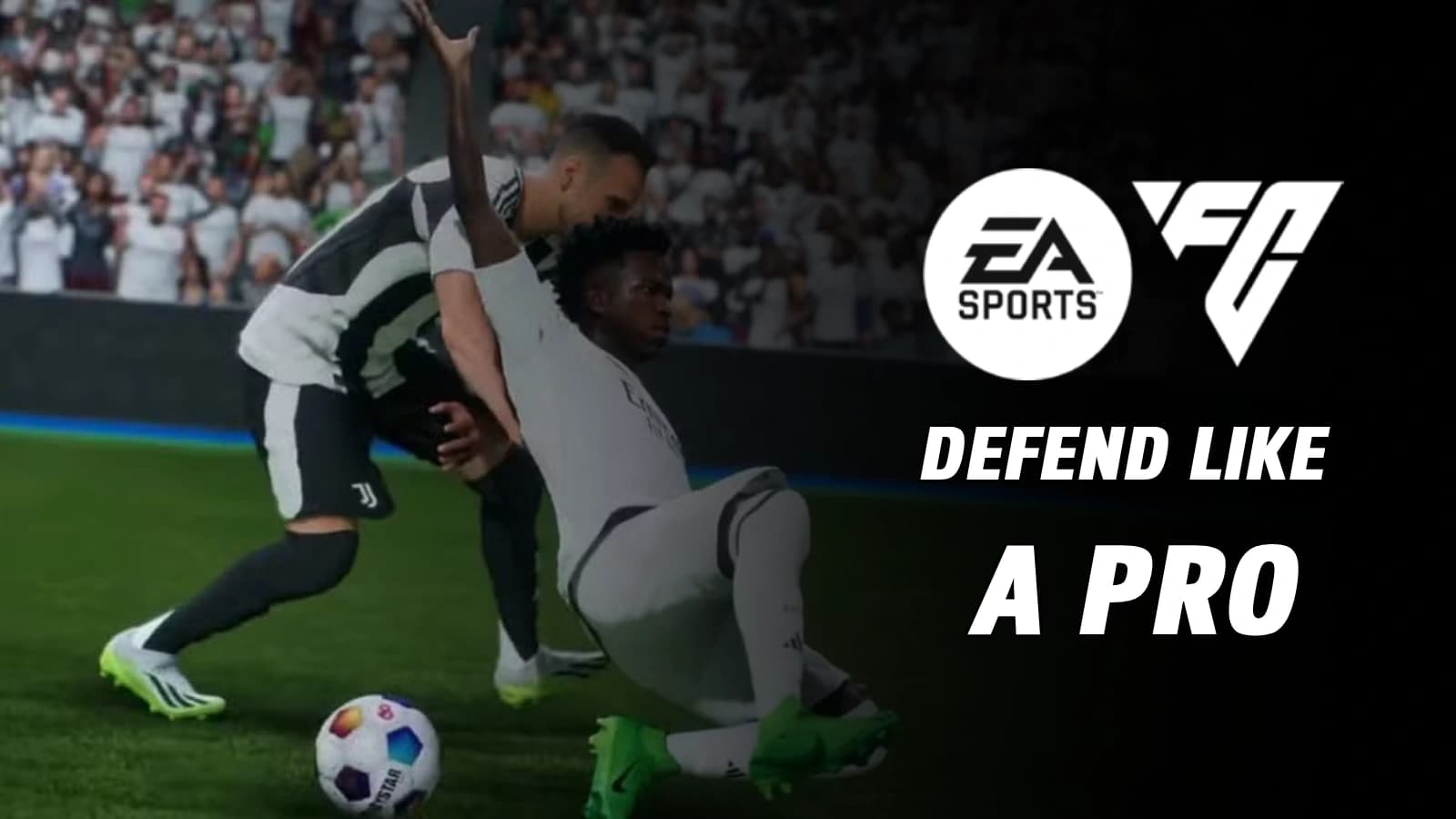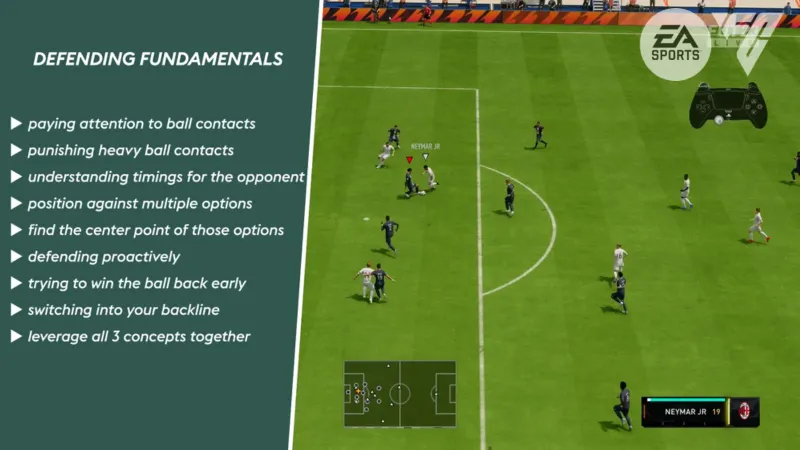
How to get better at defending in FUT
Mastering defensive play in FUT requires a combination of tactical awareness, precise timing, and disciplined positioning rather than aggressive tackling. Successful defenders focus on controlling space, anticipating opponent movements, and maintaining structural integrity throughout matches. The key lies in understanding when to engage attackers directly and when to hold your defensive line, while utilizing manual controls for optimal player switching and jockeying. These fundamental principles, combined with proper custom tactics and strategic player selection, transform average defensive performances into impenetrable walls that frustrate even the most skilled opponents.
Why Most Players Struggle with Defending?
Defensive struggles in FUT stem primarily from fundamental misconceptions about how modern football defending operates within the game’s mechanics. Many FC25 players approach defense with an overly aggressive mindset, constantly chasing the ball and abandoning positional discipline in favor of immediate tackles. This reactive approach creates systematic weaknesses that experienced attackers exploit ruthlessly through quick passing combinations and skill moves. Understanding these common pitfalls is essential for developing a more sophisticated defensive approach that emphasizes patience and tactical awareness over frantic ball-chasing. The most prevalent defensive mistakes include:
- Impatient tackling - Rushing into challenges without proper positioning or timing
- Over-reliance on AI assistance - Allowing automated defending to dictate player movements
- Poor switching mechanics - Failing to manually select the correct defender for each situation
- Breaking defensive shape - Dragging center-backs out of position to chase attacks
- Mistimed pressing - Applying pressure at inappropriate moments, exposing the backline
- Lack of anticipation - Reacting to plays instead of predicting opponent intentions
Manual Defending vs AI Assist: Pros & Cons
The debate between manual defending and AI assistance represents one of the most crucial decisions affecting defensive performance in FUT. Manual control provides unparalleled precision and tactical flexibility, allowing defenders to anticipate plays and position themselves optimally for interceptions and tackles. However, this approach demands exceptional concentration, quick reflexes, and extensive practice to master effectively. Conversely, AI-assisted defending reduces cognitive load and helps maintain basic positioning, but often lacks the nuanced decision-making required against sophisticated attacking patterns. Below is a comprehensive comparison of both approaches:
| Aspect | Manual Defending | AI Assist |
| Control Level | Complete player control | Automated positioning |
| Skill Requirement | High - demands practice | Low - accessible to beginners |
| Predictability | Unpredictable movements | Easily exploited patterns |
| Reaction Speed | Limited by user reflexes | Instant automated responses |
| Tactical Flexibility | Highly adaptable | Rigid predetermined actions |
| Learning Curve | Steep initial difficulty | Immediate usability |
Tackling Basics: Standing, Sliding, Interceptions
Effective tackling forms the cornerstone of successful defensive play, yet many players misunderstand the appropriate application of different tackle types. Each tackling method serves specific purposes and situations, requiring careful consideration of timing, positioning, and risk assessment. Standing tackles offer the safest option for close-range encounters, while sliding tackles provide last-resort solutions for desperate situations. However, interceptions represent the most sophisticated and effective defensive technique, requiring anticipation and positioning rather than reactive button pressing. Mastering these three fundamental approaches creates a comprehensive defensive toolkit:

1.Standing Tackles
Standing tackles represent the most reliable method for winning possession when positioned correctly near attacking players. Execute these tackles when you’re within close range and confident about cleanly winning the ball without committing fouls. The key lies in timing the tackle precisely as the attacker takes a heavy touch or attempts to change direction. Avoid spamming the tackle button, as this often results in mistimed challenges and potential penalties. Instead, use jockeying to position yourself optimally before committing to the standing tackle, ensuring maximum success rates.
2. Sliding Tackles
Sliding tackles should be reserved for specific high-stakes situations where other defensive options are unavailable or insufficient. These tackles work best for blocking shots, intercepting crosses, or making last-ditch challenges when attackers are through on goal. However, sliding carries significant risks including potential red cards, penalties, and leaving your defender out of position if unsuccessful. Master the timing by initiating slides just as attackers enter your tackle radius, but avoid using this technique in crowded penalty areas where contact is likely.
3. Interceptions
Interceptions represent the most sophisticated and effective defensive technique, requiring game reading skills and positional awareness rather than reactive button pressing. Successful interceptions involve predicting passing lanes, positioning defenders strategically, and timing movements to cut off opponent passes before they reach their intended targets. Focus on reading the attacking player’s body language and movement patterns to anticipate their next pass. This proactive approach proves far more consistent than reactive tackling and maintains better defensive shape throughout matches.
Right Stick Switching & Jockeying Mastery
Mastering right stick switching and jockeying techniques elevates defensive play from amateur to professional levels, providing precise control over player selection and movement. Right stick switching allows immediate access to the most appropriately positioned defender for each situation, eliminating the delays and errors associated with automatic switching systems. Combined with effective jockeying, these skills enable defenders to control space, delay attackers, and maintain optimal positioning throughout defensive phases.
The synergy between precise switching and controlled jockeying creates an impenetrable defensive foundation that frustrates even the most skilled opponents. Effective jockeying involves using L2/LT combined with subtle left stick movements to shadow attackers while maintaining defensive positioning.
This technique allows defenders to react to skill moves, track attacking runs, and control the space between attacker and goal without committing to risky tackles. Practice switching defenders with the right stick while simultaneously jockeying with your selected player, creating seamless defensive transitions that maintain structural integrity. Advanced players combine these techniques with anticipatory positioning to intercept passes and force attackers into less dangerous areas.
Top Custom Tactics to Improve Defense
Custom tactics fundamentally determine how effectively your defensive unit functions as a cohesive system, influencing everything from pressing triggers to positional discipline. Proper tactical setup transforms individual defensive skills into collective strength, creating structured resistance that opponents struggle to penetrate.
The key lies in balancing aggressive pressing with disciplined shape-holding, ensuring your defense remains compact while still applying appropriate pressure on attacking plays. Understanding these tactical nuances allows you to adapt your defensive approach based on opponent playing styles and match situations. Essential defensive custom tactics include:
- Defensive Depth (50-55) - Maintains balance between preventing through balls and avoiding deep defensive lines
- Defensive Width (45-55) - Keeps compact shape while preventing easy wide play exploitation
- Fullback Instructions - Set to “Stay Back While Attacking” for defensive stability
- Midfielder Roles - Assign at least one CM/CDM to “Cut Passing Lanes” and “Stay Back”
- Pressing Intensity - Use moderate pressing to avoid stamina depletion and defensive gaps
- Defensive Style - Balanced approach prevents both counter-attacks and possession-based attacks
Best Defenders Under 20K Coins (Updated List)
Building an effective defense doesn’t require massive coin investments, as numerous budget-friendly options provide excellent defensive capabilities for fraction of premium player costs. These affordable defenders offer impressive pace, strength, and defensive awareness statistics that compete favorably against more expensive alternatives.
Smart chemistry style applications can further enhance their performance, making them viable options even in competitive gameplay scenarios. Market fluctuations may affect exact pricing, but these players consistently offer exceptional value for money. Top budget defensive options include:
- Center-Backs: Josko Gvardiol, Ronald Araújo, Jean-Clair Todibo, Edmond Tapsoba, Fikayo Tomori
- Left-Backs: Nuno Mendes, Alejandro Balde, Alphonso Davies (when price drops)
- Right-Backs: Jeremie Frimpong, Nordi Mukiele, Achraf Hakimi (market dependent)
- Hidden Gems: Gonçalo Inácio, Castello Lukeba, Jurrien Timber
- Chemistry Styles: Shadow for pace/defending boost, Anchor for physical/defending enhancement
- Market Tips: Monitor prices during rewards releases for potential bargains
When to Press and When to Hold Shape
Understanding the appropriate timing for pressing versus maintaining defensive shape represents one of the most crucial tactical decisions in FUT defending. Effective pressing requires specific triggers and situations, while shape-holding demands patience and disciplinary positioning. Mistimed pressing creates massive gaps that skilled attackers exploit instantly, while excessive shape-holding allows opponents to build attacks unopposed. The key lies in reading game situations and opponent tendencies to determine the optimal defensive approach for each moment.
Pressing works best when opponents make heavy touches, receive passes under pressure, or when you can create numerical advantages through midfield support. However, avoid team pressing except in desperate late-game situations, as it drains stamina and exposes defensive lines. Shape-holding proves most effective against patient possession-based opponents who probe for weaknesses. Maintain compact defensive lines, force play wide, and cut off central passing lanes while waiting for opponent mistakes. This disciplined approach frustrates attackers and creates turnover opportunities without exposing your defense to counter-attacks.
Final Result
Mastering FUT defending requires patience, practice, and understanding that effective defense is built on discipline rather than aggression. By implementing proper switching techniques, tactical awareness, and strategic pressing, you’ll transform defensive weaknesses into strengths that opponents struggle to overcome. Remember that defending is a skill that develops over time through consistent application of these principles. Focus on maintaining shape, anticipating plays, and making smart decisions rather than chasing immediate results through risky tackles and pressing.
FAQ
Q: What’s the most important defending skill to master first?
A: Right stick switching is the foundation of good defending. Master this before focusing on advanced techniques, as it ensures you’re always controlling the correct player for each defensive situation.
Q: Should I use manual or assisted defending settings?
A: A combination works best. Use manual control for critical moments like interceptions and jockeying, while allowing AI assistance for supporting players to maintain overall defensive shape.
Q: How do I stop getting beaten by skill moves constantly?
A: Use jockeying (L2/LT) to delay attackers and avoid diving into tackles. Keep your defender between the attacker and goal, forcing them wide rather than allowing central penetration.
Q: What custom tactics work best for defensive stability?
A: Set defensive depth to 50-55, width to 45-55, keep fullbacks on “Stay Back While Attacking,” and assign at least one midfielder to “Cut Passing Lanes” with “Stay Back” instructions.
Q: When should I use sliding tackles?
A: Only for last-ditch situations, blocking shots, or intercepting crosses. Avoid sliding in the penalty area or when other defensive options are available, as the risks often outweigh the benefits.
Q: How do I improve my defensive positioning?
A: Focus on controlling space rather than chasing the ball. Keep defenders between attackers and goal, maintain compact lines, and use anticipation to cut off passing lanes before opponents can exploit them.


